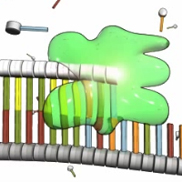4. Transcriptome -YJ code: 19425325
Transcriptome & Transcription 
Transcriptome is the full range of messenger RNA, or mRNA, molecules expressed by an organism. The term "transcriptome" can also be used to describe the array of mRNA transcripts produced in a particular cell or tissue type. In contrast with the genome, which is characterized by its stability, the transcriptome actively changes. In fact, an organism's transcriptome varies depending on many factors, including stage of development and environmental conditions. A laboratory technique called the microarray can be used to examine changes in the transcriptome. Microarrays can be used to measure the expression of thousands of genes at the same time, as well as to provide gene expression profiles, which describe changes in the transcriptome in response to a particular condition or treatment.
Transcription is the process by which the information in a strand of DNA is copied into a new molecule of messenger RNA (mRNA). DNA safely and stably stores genetic material in the nuclei of cells as a reference, or template. Meanwhile, mRNA is comparable to a copy from a reference book because it carries the same information as DNA but is not used for long-term storage and can freely exit the nucleus. Although the mRNA contains the same information, it is not an identical copy of the DNA segment, because its sequence is complementary to the DNA template.
Reference :
1. http://www.nature.com/scitable/definition/transcriptome-296